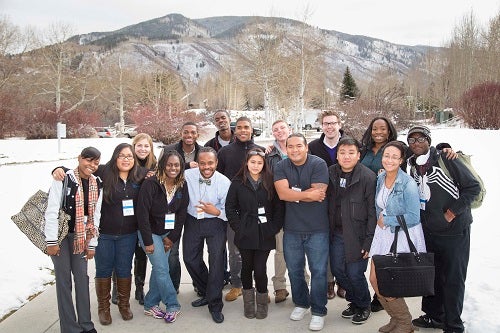
Youth leaders from Opportunity Youth Incentive Fund communities met in Aspen at last year’s OYIF Fall Convening.
America currently has an estimated 6.7 million “opportunity youth:” young people between the ages of 16 to 24 in the US who are neither enrolled in school nor participating in the labor market. The Aspen Institute Forum for Community Solutions (AFCS) created the Opportunity Youth Incentive Fund (OYIF) in 2012 to build evidence for and promote strategies to improve the education and employment outcomes of this group.
With millions of dollars in the Fund provided to communities across the country, the OYIF Fall Convening will bring together grantees and partners in Aspen, CO, at the end of the month. During the two-day convening the attendees will share insights on reengaging opportunity youth to education and employment, coordinating across systems and sectors, and adding the youth voice to this work.
Leading up to the event, several OYIF members working in the field discussed their work from various lenses — the funder, community, and the youth leader. Read below to hear from some of the people impacting youth through the OYIF, including AFCS Chair and former White House Domestic Policy Council Director Melody Barnes.
 The Youth Leadership Perspective
The Youth Leadership Perspective
Being a youth leader at the Opportunity Youth Incentive Fund’s convenings is a unique and humbling platform. Despite what one might assume, the networking and relationship building is always unforced. In a sea of other OYIF stakeholders like policy experts, nonprofit CEOs, and government officials, serving as a youth leader is regarded with the same esteem. Read more…
By Chauncy Lennon
Philanthropy sees the ebb and flow of buzzwords, new ideas, and fads that are going to change the world. But the concept of collective impact is no flash in the pan. Early successes in communities across the country suggest that this approach deserves our attention. Read more…
 The Community Perspective, Part 1
The Community Perspective, Part 1
By The Hopi Opportunity Youth Initiative
Early on, we decided that our pathway development needed to leverage Hopi strengths. Our solutions needed to be low to the ground and rely on local community resources. They needed to be rooted in the Hopi culture. And they needed to leverage the web of family, clan, and village relations that have sustained us in the past. Read more…
 The Community Perspective, Part 2
The Community Perspective, Part 2
By Employment and Mobility Pathways Linked for Opportunity Youth
In the next five years, it’s projected that 42,000 positions in the petrochemical, advanced manufacturing, and energy industries will become available, the majority of which will require a high school degree and various levels of skilled training. At the same time, there are 30,000 opportunity youth — young men and women between the ages of 16 and 24 who are disconnected from employment and education — in the New Orleans region. We recognized that by collaborating across systems, we could change the lives of the area’s opportunity youth while simultaneously bolstering the economy for the city and region. Read more…
By Melody Barnes, chair of the Aspen Forum for Community Solutions
The work to reengage 6.7 million opportunity youth through collective impact initiatives across the country started as a persistent, determined whisper for change. Today, it has become a full-throated chorus, but that evolution did not occur overnight. Anyone who works with mission-oriented organizations can tell you there is no formula or playbook for movement building. Achieving authentic and sustained commitment to a common goal takes hard work, coordination, and collaboration among key stakeholders. Read more…
 The Funder Perspective
The Funder Perspective The AFCS Perspective
The AFCS Perspective
